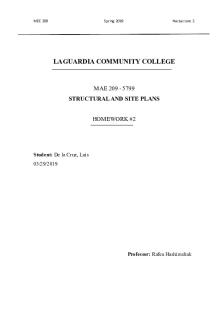Material Requirement Planning Lecture PDF

| Title | Material Requirement Planning Lecture |
|---|---|
| Author | Lauren Foster |
| Course | Operations Management |
| Institution | Edge Hill University |
| Pages | 2 |
| File Size | 48.5 KB |
| File Type | |
| Total Downloads | 714 |
| Total Views | 949 |
Summary
Material Requirement Planning Different materials are needed for different quantities and times for delivery are planning for materials therefore needs careful planning. This is a planning process that translates the master production schedule into planned order. The master production schedule is a ...
Description
Material Requirement Planning
Different materials are needed for production; different quantities and times for delivery are required; planning for materials therefore needs careful planning. This is a planning process that translates the master production schedule into planned order. The master production schedule is a master plan for what a company plans to produce and how much inventory would be required to meet the demand and when to produce it. Suppliers can be spread across the globe so careful consideration is required to decide which supplier to use. MRP requires; o Master production schedule. o Bill of Materials. o Inventory Record.
You need to enlarge the master production schedule before making an MRP, identifying which parts and assemblies are required, checking whether the required parts and assemblies are available and generating the appropriate works. The objective of MRP is to improve the production process and procurement of component parts and raw materials. This needs to be done with clear monitoring. To ensure availability of inventory to support production as to when it is needed. To increase the utilisation of labour; crucial components need precision when deciding how many days theyre needed for (focussing on cutting costs and making the most of resources.) Increased customer service. The master production schedule directly feeds into the MRP. The MPS is combined with actual customer orders and forecast demand to help form an effective and accurate MRP. Demand and forecast are different, forecast is purely an estimate and orders are an actuality, there is no guarantee that customers will live up to the forecast. Orders from customers are also bound to change. Suppliers can provide issues, they could supply products that do not meet the required level of quality. MRP also has BOM and inventory records fed into it, and from the MRP we can take purchase orders, material plans. The bill of materials I a listing of all the parts and raw materials that will go into the parent assembly, showing the quantity of each required to make an assembly. Every product has a product structure tree, at the top is the product, with each lower level breaking down the assembly piece by piece. Each level tells you how long it will take to move to the next level of production. Each level can take a different amount of time to produce, and the final product cannot be fully composed until certain levels are complete. You begin producing certain components ahead of time so that everything interlinks perfectly and syncs well so that you are not waiting for any component to be made in order to make the final product. Certain pars cannot be made if some raw materials are missing. The production line can be negatively effected if suppliers are late.
Assembly time charts are used to detail when certain components will be assembled and how they feed into creating the final product. Helps to identify the interdependencies. Expanding the bill of materials tells us when we need to order and how much is needed to order. MRP also has key components such as gross requirements (what is needed now), scheduled receipts, projected ending inventory (inventory you think you will have at the end of a trading period), net requirements (sorting out what next requirements are), planned orders. MRP will be linked to supplier systems, and suppliers do their own schedueling based on the information you give them, giving the wrong information to them will cause an error to go right down the supply chain. Capacity requirements tell us how much an organisation can hold or produce; how many units can be produced? You can only produce within your capacitys limits. Load reports detail known or expected future capacity limits MRP directly ties to MPS and indicated exact timing and quantity of orders for all components. It allows managers to trace every order. Advanced MRP 2 systems look at client and server architecture, graphic user interfaces, multiple database supports, front end systems for decision support, automated electronic data interchange. These systems are not cheap and are a major investment....
Similar Free PDFs

MATERIAL REQUIREMENT PLANNING (MRP)
- 20 Pages

Lecture 12 helping material
- 98 Pages

Well Planning - Lecture notes 1
- 31 Pages

Final Requirement
- 25 Pages

Site planning Hw Lecture 5
- 18 Pages

Site planning Hw Lecture 2
- 8 Pages

Profit Planning - Lecture notes 9
- 22 Pages

Site planning Hw Lecture 9
- 11 Pages

HR Planning - Lecture notes 4
- 15 Pages
Popular Institutions
- Tinajero National High School - Annex
- Politeknik Caltex Riau
- Yokohama City University
- SGT University
- University of Al-Qadisiyah
- Divine Word College of Vigan
- Techniek College Rotterdam
- Universidade de Santiago
- Universiti Teknologi MARA Cawangan Johor Kampus Pasir Gudang
- Poltekkes Kemenkes Yogyakarta
- Baguio City National High School
- Colegio san marcos
- preparatoria uno
- Centro de Bachillerato Tecnológico Industrial y de Servicios No. 107
- Dalian Maritime University
- Quang Trung Secondary School
- Colegio Tecnológico en Informática
- Corporación Regional de Educación Superior
- Grupo CEDVA
- Dar Al Uloom University
- Centro de Estudios Preuniversitarios de la Universidad Nacional de Ingeniería
- 上智大学
- Aakash International School, Nuna Majara
- San Felipe Neri Catholic School
- Kang Chiao International School - New Taipei City
- Misamis Occidental National High School
- Institución Educativa Escuela Normal Juan Ladrilleros
- Kolehiyo ng Pantukan
- Batanes State College
- Instituto Continental
- Sekolah Menengah Kejuruan Kesehatan Kaltara (Tarakan)
- Colegio de La Inmaculada Concepcion - Cebu






